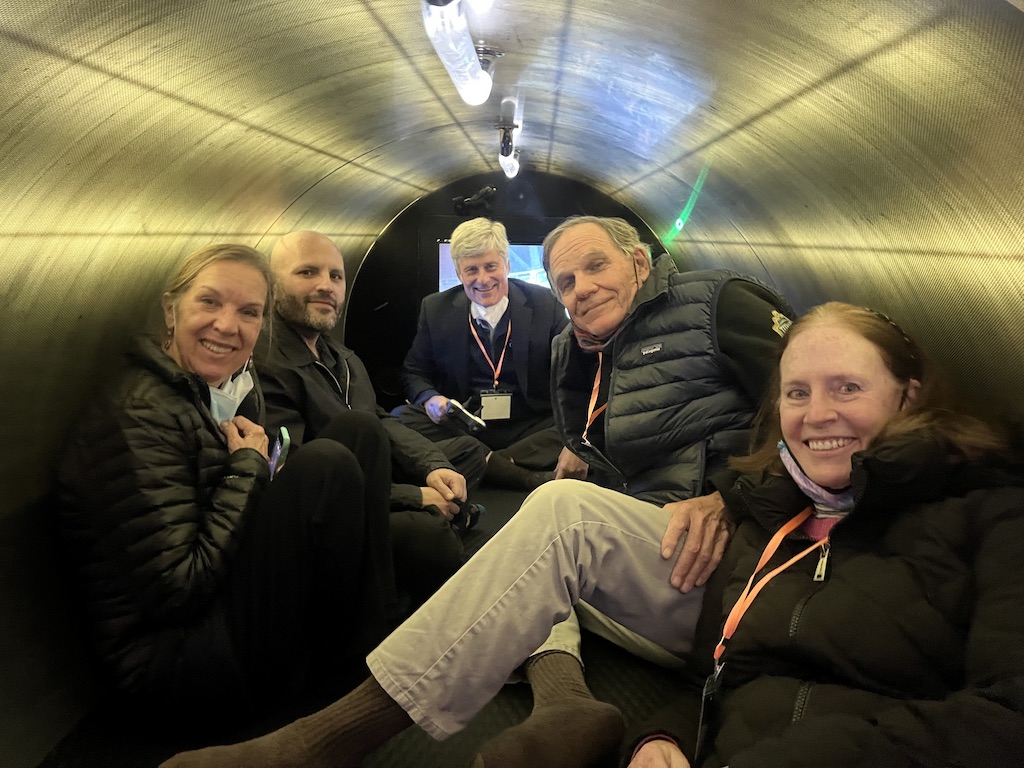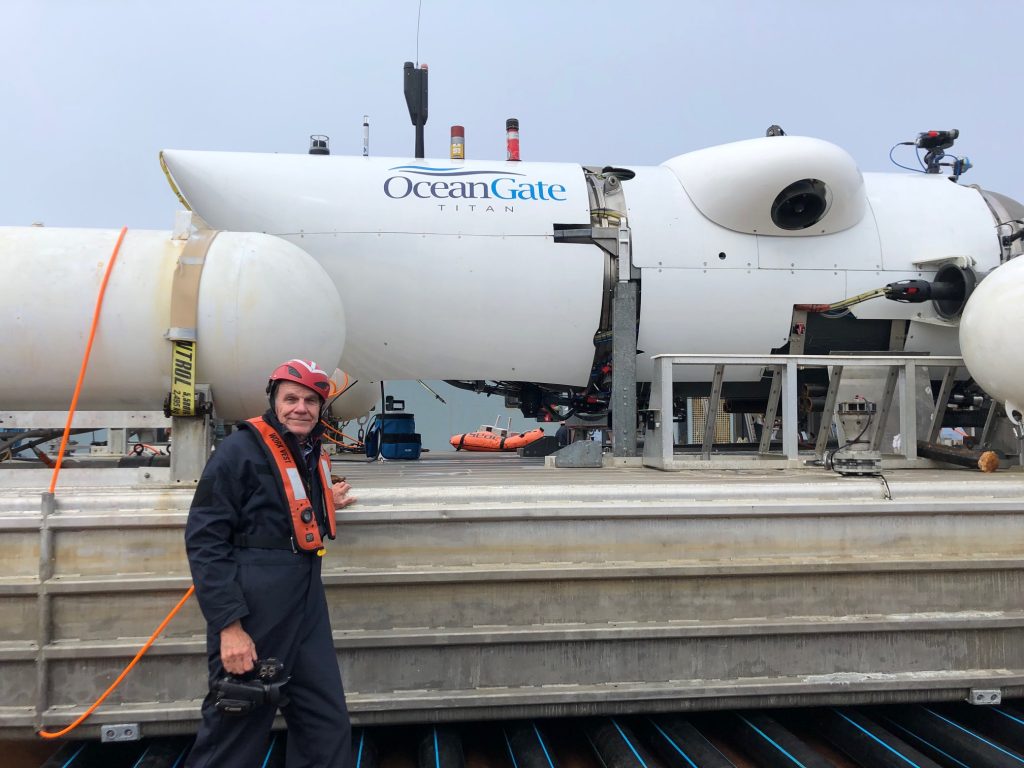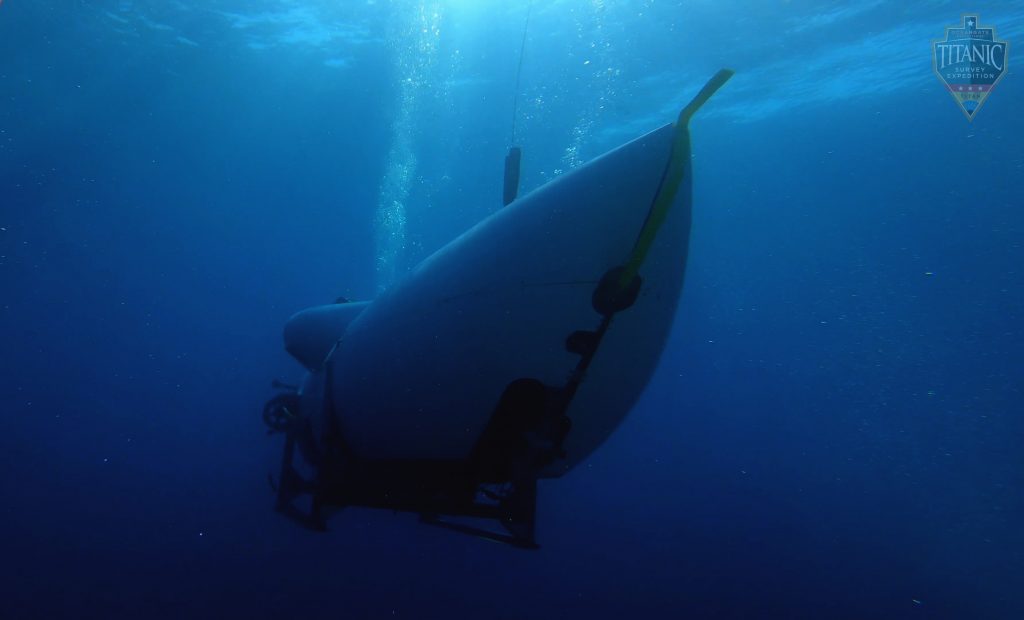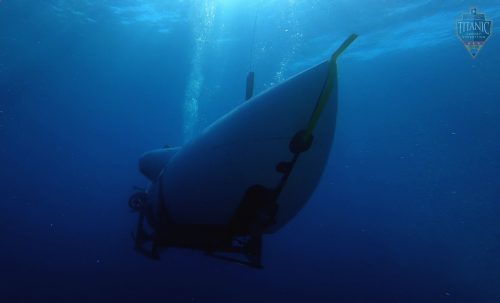Lake Forest’s David Waud Goes to the Bottom of the Ocean to See the Titanic

By David A. F. Sweet
Journeys into space have made headlines recently. But what about those who, instead of being flung into the atmosphere, choose to head the other way — to the bottom of the ocean?
A decade after he first became interested in seeing the Titanic – the luxury steam liner that struck an iceberg more than a century ago and sank, killing more than 1,500 souls — David Waud plunged about 2 1/2 miles into the North Atlantic Ocean. Packed into a five-person submersible named Titan with no room to stand during the hours-long journey, Waud was amazed as they landed softly on the ocean floor.
“That was when I realized I was in another world completely,” he said. “It’s almost impossible to describe the experience of cruising along the ocean floor, mesmerized by the debris and the mangled stern section of the decaying ship. We saw plates and cups and wine bottles and the huge engines.
“The audio I recorded inside Titan is a great testament to our shared excitement. ‘Absolutely amazing!’ and ‘Awesome!’ are heard over and over again. It was the most exciting and rewarding trip I’ve ever been on.”

David Waud (second from right), his wife Pam, pilot Stockton Rush and two others gather inside the Titan submersible when it was displayed at Gorton Community Center in Lake Forest.
The size of the deteriorating Titanic is immense – nearly as long as three football fields. It featured 29 boilers weighing 80 tons each that powered the steam engines. Amazingly, some spots on the ship remain intact, such as portholes that still contain glass – just like during its maiden voyage in 1912. Scores of species of fish swim about its wreckage.
Stockton Rush served as the pilot of Waud’s dive to the bottom of the sea. He is the chief executive officer of OceanGate, which offers tours of the Titanic for about $250,000. He said Waud’s excitement during the journey was palpable.
“David was as eager as anyone, taking hundreds of pictures and asking lots of questions,” Rush said. “He will forever be known for spilling a bag of almonds, some of which floated around condensed water inside and flooded out of the sub when the dome was opened — much to the surprise of the surface crew.”
On July 31, Waud departed Newfoundland in the support ship Horizon Arctic to start his eight-day expedition in the North Atlantic Ocean and, 380 miles later, hovered high above the Titanic. In early August, he entered the submersible with four others, including Rush. They spent 2 ½ hours heading down to 12,600 feet below sea level, enjoyed five hours looking through a small porthole and checking a live video feed to examine what remains of the steamship and then returned to the surface 2 ½ hours later.

“It was the most exciting and rewarding trip I’ve ever been on,” said David Waud about traveling 2 1/2 miles to the bottom of the ocean to see the wreckage of the Titanic.
About 300 people crawled into the submersible at the Gorton Community Center in Lake Forest on Nov. 20-21 (including yours truly), and some were stunned at the cramped quarters (including yours truly). An OceanGate representative described it as similar to being in the back of a van, though the ceiling seemed even lower than that. Waud said he neither felt claustrophobic nor did his body cramp up as it might have above sea level, no doubt because of the thrill of his venture.
“It is really well-designed, and it’s great for seeing things,” Waud said. “I felt like we were in a sophisticated submarine rather than a tube. But I wouldn’t want to put one more person in there I don’t think.”
And what if the submersible encountered troubles? Rush said there are many backup systems, including an inflatable bag that helps lift the vessel and thrusters.
“Even if everyone is incapacitated, we can get it to the surface,” he said.
On the days the submersible did not go to visit the Titanic with other visitors, Waud said the group watched fascinating in-depth presentations from team members on a variety of subjects dealing with the deep sea. The support boat was so well built that no one felt it rocking amid 12-foot waves. It even featured a hospital, as anyone with a major injury or illness would otherwise face a nine-hour trip back to helicopter range from North America.
Waud is working on a personal film of the expedition, which he expects to release in the late spring and show at Chicago area non-profits he has supported. Lest you think the Titanic is his only highlight of being below sea level this year, he also visited Death Valley, where Waud stood 282 feet below sea level – the lowest point on land in North America.

“David was as eager as anyone, taking hundreds of pictures and asking lots of questions,” said Stockton Rush, pilot of the Titan.
How did a septuagenarian who grew up in the Midwest become so fascinated by the sea? After graduating from Princeton University with an economics major in 1969, Waud taught mathematics at a private school in Winter Park, Fla. Eight geometry students persuaded him to join them in a scuba-diving class, even though he had never even snorkeled, and he acquired a new nickname – Jacques Waudeau, based on the famous underwater explorer Jacques Cousteau.
“Before that I really didn’t know what you found in the ocean,” said Waud, who started a group called Coral Creepers which scuba-dived in the Atlantic for four years.
On a trip later to Truk Lagoon in Japan, site of many shallow shipwrecks during World War II, he became hooked on underwater photography. He started Underwauder Productions and gave presentations at 1,600 schools over 35 years about the world of the sea.
Will Waud head down to the Titanic again? He’d love to go in 2022, though he noted many things need to fall into place for that to happen. But even if that doesn’t occur, he does have something else to look forward to many years down the line.
“I’ve always told the joke that I’ve wanted to go down to see the Titanic because when I’m in a nursing home one day, they’ll all point to me and say, ‘He’s the guy who went down to see the Titanic.’”
Unsung Gems columnist David A. F. Sweet is the author of Three Seconds in Munich. He can be reached at dafsweet@aol.com.







